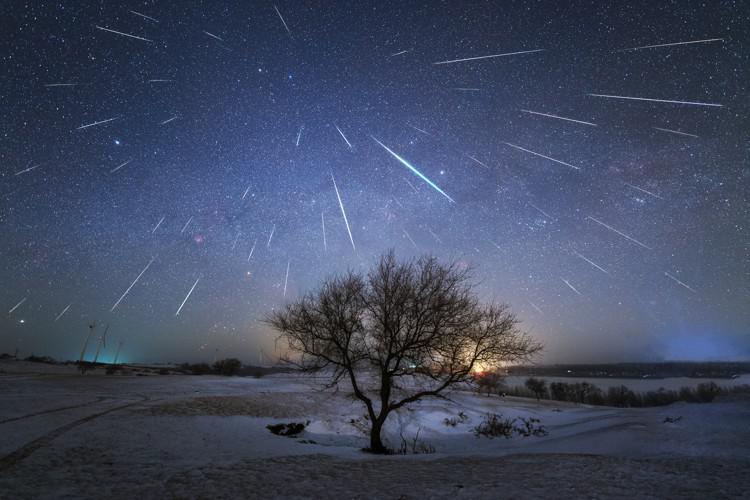This page describes an image Geminid Meteor Shower from China, by Dai Jianfeng, China
Caption:
First place in the 2021 IAU OAE Astrophotography Contest, category Meteor showers.
A meteor shower occurs when the Earth in its orbit around the Sun, passes through a debris trail left previously by a comet on its approach around the Sun. As the Earth enters this debris (small sand grain sized), they enter the atmosphere at high speeds and on parallel trajectories, burning completely leaving beautiful tracks (streaks) in the sky. These streaks can appear and disappear in the blink of an eye, or last much longer. On rare occasions the debris originates from asteroids, as in the case of the Geminid meteor shower, shown in this image, picturing many streaks of debris captured in the sky of China in 2017. Due to relative motions and perspective, the shower appears to come from one single point, known as the radiant point, beautifully pictured in this image. This is similar to driving in a car on a rainy day without any wind, looking out the front window it seems that the rain is coming directly towards the window, when in fact the rain is falling vertically downwards.
Credit:
Dai Jianfeng/IAU OAE
DOI: 10.5281/zenodo.5367235
Related glossary terms:
Shooting Star
Categories:
Naked Eye Astronomy
License: Creative Commons Attribution 4.0 International (CC BY 4.0) Creative Commons Attribution 4.0 International (CC BY 4.0) icons
The media file captions presented on the OAE website were written, translated and reviewed by a collective effort from the OAE, the OAE Centers and Nodes, the OAE National Astronomy Education Coordinators (NAECs) and other volunteers. You can find a full list of credits for our translation project here. All media file captions are released under a Creative Commons CC BY-4.0 license and should be credited to "IAU OAE". The media files themselves may have different licenses (see above) and should be credited as listed above under "credit".
Captions in Different Languages:
Caption: Primo posto al concorso di astrofotografia IAU OAE 2021, categoria Piogge meteoriche.
Una pioggia di meteoriti si verifica quando la Terra, nella sua orbita intorno al Sole, attraversa una scia di detriti lasciata in precedenza da una cometa nel suo avvicinamento al Sole. Quando la Terra entra in contatto con questi detriti (delle dimensioni di piccoli granelli di sabbia), essi entrano nell'atmosfera ad alta velocità e su traiettorie parallele, bruciando completamente e lasciando bellissime tracce (strisce) nel cielo. Queste strisce possono apparire e scomparire in un batter d'occhio, o durare molto più a lungo. In rare occasioni i detriti provengono da asteroidi, come nel caso della pioggia di meteore Geminidi, mostrata in questa immagine, che raffigura molte strisce di detriti catturate nel cielo della Cina nel 2017. A causa dei moti relativi e della prospettiva, la pioggia sembra provenire da un unico punto, noto come punto radiante, splendidamente rappresentato in questa immagine. È un po' come guidare in auto in una giornata di pioggia senza vento: guardando fuori dal parabrezza sembra che la pioggia arrivi direttamente verso il vetro, mentre in realtà sta cadendo verticalmente verso il basso.
Credit: Dai Jianfeng/IAU OAE
Related glossary terms: Stella cadente Caption translation status: Approved by a reviewer
Caption translators: Giuliana Giobbi, Francesco Salvestrini
Caption reviewers: Rosa Valiante, Rodolfo Canestrari









